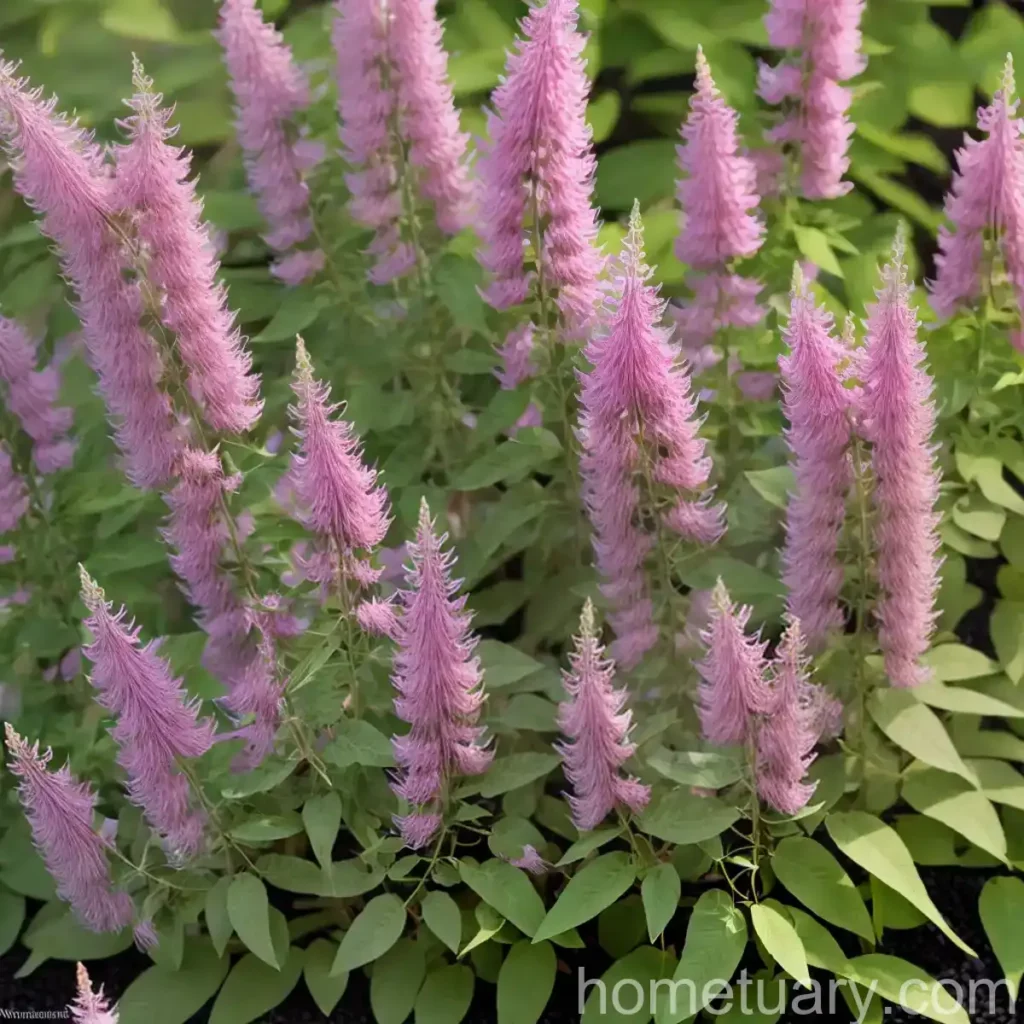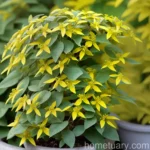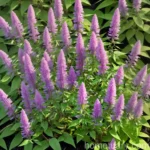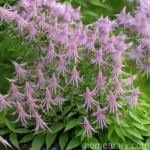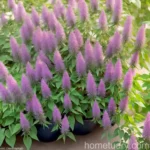Bush Clover (Lespedeza thunbergii ‘Gibraltar’)
Bush clover, scientifically known as Lespedeza thunbergii ‘Gibraltar’, is an exquisite ornamental perennial plant cherished by horticulturists and garden enthusiasts alike. Its striking beauty, low maintenance requirements, and versatility make it a popular choice for landscapes and gardens. This article aims to provide comprehensive insights into the characteristics, cultivation, and uses of the bush clover plant, offering valuable information for both amateur and experienced gardeners.
Key Takeaways – Bush Clover (Lespedeza thunbergii ‘Gibraltar’)
- Scientific Name: Lespedeza thunbergii ‘Gibraltar’
- Common Names: Bush Clover, Gibraltar Bush Clover
- Family: Fabaceae (Legume family)
- Hardiness: USDA Zones 4-9
- Water Needs: Moderate
- Sunlight: Full Sun to Partial Shade
- Soil: Well-draining, Loamy Soil
- Height: 3-4 feet
- Spread: 4-5 feet
- Flowering: Late Summer to Early Fall
- Maintenance: Low
What is Bush Clover (Lespedeza thunbergii ‘Gibraltar’)?
Bush clover, or Lespedeza thunbergii ‘Gibraltar’, is a deciduous perennial plant characterized by its elegant, arching branches adorned with vibrant, pea-like flowers in shades of pink, purple, or white. Belonging to the Fabaceae family, this cultivar is a compact and rounded shrub that adds visual interest to gardens and landscapes, particularly during the late summer and early fall when its abundant blooms create a captivating display.
This cultivar is a variation of the Lespedeza thunbergii species, distinguished by its Gibraltar cultivar-specific traits, including its growth habit, flower color, and overall landscape appeal. With proper care and suitable growing conditions, bush clover can thrive in various settings, from mixed borders and cottage gardens to naturalized landscapes and urban plantings.
Culture
Uses
Bush clover (Lespedeza thunbergii ‘Gibraltar’) holds diverse functional and ornamental uses in horticulture and landscaping due to its:
- Aesthetic Appeal: The plant’s graceful form and bountiful flowers make it a captivating addition to gardens, offering visual appeal throughout the growing season.
- Wildlife Habitat: As a pollinator-friendly plant, bush clover attracts bees, butterflies, and other beneficial insects, supporting local ecosystems and biodiversity.
- Cut Flower: Its long, arching stems with abundant blooms make bush clover an excellent choice for cut flower arrangements, further enhancing its usability in floral displays.
- Erosion Control: In naturalized landscapes and restoration projects, bush clover can contribute to soil stabilization and erosion control efforts with its robust root system.
Water
Proper water management is crucial for ensuring the healthy growth and development of bush clover. While the plant exhibits moderate drought tolerance once established, consistent moisture is essential during its initial establishment and periods of prolonged dryness.
Watering Tips for Bush Clover:
- Establishment: During the first growing season, water regularly to help the plant establish a strong root system. Monitor soil moisture and ensure it remains consistently damp but not waterlogged.
- Mature Plants: Once established, bush clover generally requires water during extended dry spells. However, it is crucial to avoid overwatering, as excessive moisture can lead to root rot and other issues.
Sunlight
Bush clover thrives in locations with adequate sunlight, though it also displays tolerance to partial shade. When selecting a planting site, it is essential to consider the sunlight requirements for optimal growth and flowering performance.
Sunlight Requirements for Bush Clover:
- Full Sun: Planting in full sun (6-8 hours of direct sunlight per day) is ideal for promoting vigorous growth and profuse flowering.
- Partial Shade: While bush clover prefers full sun, it can tolerate partial shade, particularly in regions with intense afternoon sunlight or high temperatures.
Fertilizer
Appropriate fertilization can support the vitality and blooming capacity of bush clover, offering essential nutrients for robust growth and prolific flowering.
Fertilizing Bush Clover:
- Spring Application: In early spring, apply a balanced, slow-release fertilizer around the base of the plant to provide essential nutrients for the upcoming growing season.
- Minimal Requirements: Bush clover generally thrives in average to fertile soils and may not require heavy fertilization if planted in nutrient-rich garden beds. However, a light feeding annually can promote optimal performance.
Soil
The soil composition and quality play a significant role in the health and vigor of bush clover. By ensuring proper soil conditions, gardeners can facilitate strong root development and abundant flowering in this ornamental perennial.
Soil Requirements for Bush Clover:
- Well-Draining Soil: Bush clover thrives in well-draining, loamy soil that prevents waterlogging and promotes aeration around the root zone.
- pH Level: The ideal soil pH for bush clover ranges from slightly acidic to neutral (pH 6.0-7.0), providing an optimal environment for nutrient uptake and overall plant health.
Pruning
Pruning practices are essential for maintaining the shape, vigor, and flowering performance of bush clover. Regular pruning helps to remove dead or damaged growth, improve air circulation, and stimulate new growth for a healthy and attractive plant.
Pruning Guidelines for Bush Clover:
- Early Spring: In late winter or early spring, prune bush clover to remove any dead, diseased, or weak branches. Additionally, consider shaping the plant to maintain a well-balanced and compact form.
- Deadheading: To encourage prolonged flowering, deadhead spent blooms throughout the blooming season, promoting continuous flower production.
Propagation
Propagating bush clover allows gardeners to expand their plant collection and share this stunning cultivar with fellow enthusiasts. Understanding the propagation methods for bush clover provides opportunities for creating new plants from established specimens.
Propagation Techniques for Bush Clover:
- Division: During early spring or fall, divide mature clumps or root sections of bush clover to create new plants. Ensure each division has adequate roots and stems for successful establishment.
- Softwood Cuttings: In early summer, take softwood cuttings from healthy, actively growing shoots of bush clover. Root the cuttings in a well-draining medium to initiate new plants.
Container Popularity
The compact size and ornamental appeal of bush clover make it a sought-after choice for container gardening and ornamental patio displays. When grown in containers, this plant offers versatility and aesthetic enhancement to outdoor living spaces, balconies, and patios.
Benefits of Container-Grown Bush Clover:
- Space Optimization: Ideal for smaller gardens or urban settings, container-grown bush clover maximizes space while adding visual interest and seasonal color.
- Portability: Containers allow for easy repositioning and mobility, enabling gardeners to showcase the plant in various locations based on seasonal preferences or design changes.
Common Diseases
While bush clover is relatively resistant to many common pests and diseases, it may occasionally encounter certain issues that can affect its health and appearance. Being aware of potential diseases and their management is crucial for preserving the vitality of this ornamental cultivar.
Disease Resistance and Management:
- Powdery Mildew: Bush clover may be susceptible to powdery mildew, particularly in conditions of high humidity and poor air circulation. To mitigate this issue, ensure proper spacing and ventilation around plants and consider fungicidal treatments if necessary.
- Root Rot: Excessive soil moisture and poorly draining soil can lead to root rot in bush clover. Implement proper water management practices and avoid overwatering to prevent this issue.
Common Pests
In general, bush clover is relatively resistant to many common garden pests; however, occasional pest pressures may arise, necessitating appropriate pest control measures.
Potential Pests and Management:
- Aphids: These small, sap-feeding insects can sometimes infest bush clover, causing distorted growth and honeydew buildup. Employing beneficial insects, such as ladybugs, or using insecticidal soaps can help manage aphid populations effectively.
Botanist’s Tips
As a plant scientist and enthusiast, here are some additional insights and recommendations for the successful cultivation and enjoyment of bush clover in garden settings:
- Companion Planting: Pair bush clover with companion plants that complement its color, texture, and seasonal interest, such as asters, ornamental grasses, or late-blooming perennials.
- Wildlife Support: Create a pollinator-friendly garden environment by incorporating bush clover along with other nectar-rich flowers to attract and support beneficial insects, birds, and butterflies.
- Winter Care: While bush clover is deciduous, providing a layer of mulch around the base of the plant in late fall can offer protection and insulation during winter months, promoting healthy regrowth in the following spring.
Fun Facts
- In its native habitat, Lespedeza thunbergii is commonly found in the woodlands and hillsides of Asia, where it contributes to the natural beauty of the landscape.
- The name “Lespedeza” commemorates the Spanish governor of East Florida, Vicente Manuel de Céspedes.
- Bush clover symbolizes perseverance and hope in the language of flowers, adding a meaningful significance to its ornamental value.
Links to External Resources
For additional information, resources, and visual references related to bush clover (Lespedeza thunbergii ‘Gibraltar’), please explore the following links:
- The American Society for Horticultural Science
- Royal Horticultural Society – Gardening Advice
- University Extension Services – Horticulture and Gardening
As an ornamental perennial with captivating blooms and graceful habit, bush clover (Lespedeza thunbergii ‘Gibraltar’) offers a wealth of benefits and visual appeal in various landscape and garden settings. With the insights provided in this article, gardeners and horticulture enthusiasts can enhance their understanding of this cultivar, cultivate it successfully, and appreciate its ornamental and ecological contributions to the outdoor environment. Whether used as a standalone specimen, a companion accent, or a beneficial pollinator attractant, bush clover remains a cherished and versatile addition to diverse horticultural pursuits.

